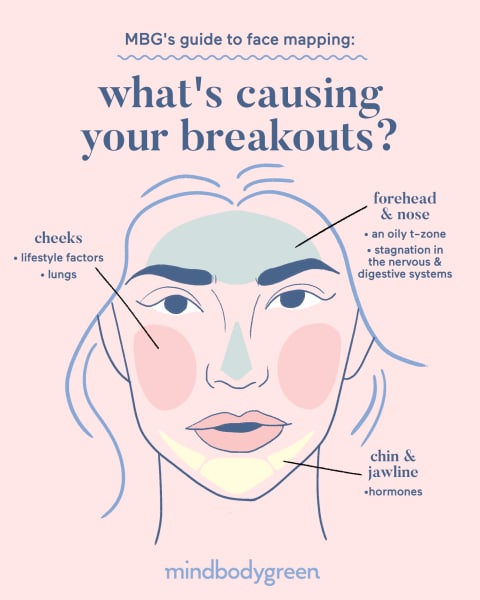This practice is known as acne face-mapping. Because science has yet to fully back up these claims, face-mapping is controversial in the dermatologic world—but that’s not to say that the type of acne you’re experiencing doesn’t offer its own clues, too. In ayurvedic face-mapping, this area of the face is commonly tied to stagnation in the nervous and digestive systems; that is, digestive issues and stress-inducing experiences, such as lack of sleep or periods of high emotion, can ignite acne in these areas. Acne in this area can also be triggered by lifestyle factors. For example, “those who hold their phone up to their cheek a lot can develop acne where the screen contacts the face,” Icecreamwala explains. Other potentially acne-inducing habits include sleeping on dirty pillowcases (aim to change them at least once per week) and touching your face throughout the day with dirty fingers. Redness and breakouts on the cheeks are also a common symptom of rosacea—something that’s often confused with acne. If you having been treating your breakouts in the area with typical acne treatments and it hasn’t helped, consider visiting a dermatologist who can identify signs of rosacea and offer better treatment solutions. “This does not mean that there are hormonal irregularities in your blood,” Icecreamwala explains. “It means that your oil glands are more sensitive to hormones that your body naturally produces.” The primary hormones thought to incite this type of acne include estrogens, progesterone, growth hormone, and androgens. Blackheads can be brought on by skin that simply produces too much oil, which often takes place during times of hormonal changes, such as pregnancy, menstruation, or teenage years. The key to preventing and treating blackheads is to properly and sufficiently cleanse your skin, including regular gentle exfoliation, which will swipe away those potentially problematic dead skin cells. Oftentimes, for cases of extra stubborn blackheads, dermatologists recommend the use of topical salicylic acid, retinoids, and even extractions. Treating whiteheads, and preventing their return, is therefore often focused on unclogging pores—usually with some type of exfoliating cleanser, either physical or chemical. Like blackheads, this overproduction of oil is often tied to a hormonal shift or consuming dairy2. Often, cystic acne is the result of large hormonal imbalances. Cystic acne should also always be treated by a board-certified dermatologist, and the very worst thing you can do for cystic breakouts is to touch, squeeze, or try to pop the lesions.




